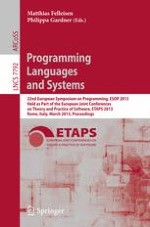2013 | Book
Programming Languages and Systems
22nd European Symposium on Programming, ESOP 2013, Held as Part of the European Joint Conferences on Theory and Practice of Software, ETAPS 2013, Rome, Italy, March 16-24, 2013. Proceedings
Editors: Matthias Felleisen, Philippa Gardner
Publisher: Springer Berlin Heidelberg
Book Series : Lecture Notes in Computer Science
